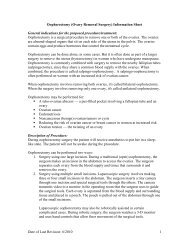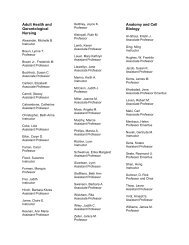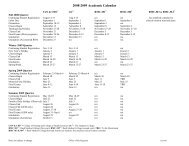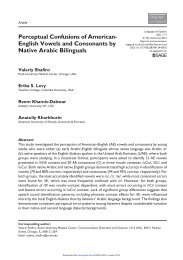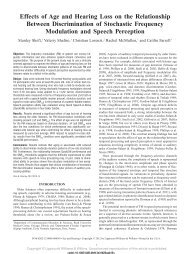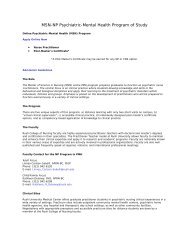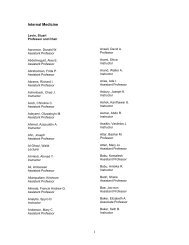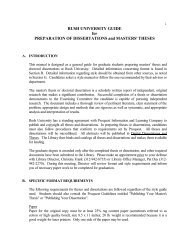Perceptual confusions of American English vowels ... - Rush University
Perceptual confusions of American English vowels ... - Rush University
Perceptual confusions of American English vowels ... - Rush University
You also want an ePaper? Increase the reach of your titles
YUMPU automatically turns print PDFs into web optimized ePapers that Google loves.
5pSWa35. Perception <strong>of</strong> phonemic and allophonic contrasts in <strong>English</strong>and<br />
Spanish-learning infants. Morgan Meredith Commun. Sci. & Disord.,<br />
Northwestern Univ., 2240 Campus Dr., Evanston, IL 60208,<br />
morgan.leigh@me.com and Jessica Maye Northwestern Univ., Evanston,<br />
IL 60208<br />
Infants from monolingual <strong>English</strong>- and Spanish-speaking homes were<br />
compared in their perception <strong>of</strong> two phonetic contrasts that differ in their<br />
phonemic status in the two languages. The contrast d-ð is phonemic in<br />
<strong>English</strong> but allophonic in Spanish; while the contrast d-flap is phonemic in<br />
Spanish but allophonic in <strong>English</strong>. Infants ranged from 6 to 16 months <strong>of</strong><br />
age. Each infant was tested on discrimination <strong>of</strong> both contrasts. For half <strong>of</strong><br />
the infants the stimuli were produced by a Spanish speaker, while for the<br />
other half <strong>of</strong> the infants the stimuli were produced by an <strong>English</strong> speaker.<br />
Data collection from Spanish-learning infants is still in progress. However,<br />
preliminary results indicate that infants in the youngest age group 6–8<br />
months are able to discriminate the d-flap contrast regardless <strong>of</strong> infant<br />
language background, while the d-ð contrast is discriminated poorly at<br />
this age in both language groups. <strong>English</strong>-learning infants lose sensitivity to<br />
the allophonic d-flap contrast with age, and it is not until 14–16 months<br />
that discrimination <strong>of</strong> the phonemic d-ð contrast improves in these<br />
infants. Spanish-learning infants are expected to remain pr<strong>of</strong>icient at discriminating<br />
the phonemic d-flap as they age and to remain poor at discriminating<br />
the allophonic d-ð contrast. Work supported by<br />
NIH1R03HD048538 to JM.<br />
5pSWa36. The effects <strong>of</strong> linguistic experience on the perception <strong>of</strong><br />
breathy phonation. Christina Esposito Dept. <strong>of</strong> Linguist., Macalester College,<br />
1600 Grand Ave., St. Paul, MN 55105, esposito@macalester.edu<br />
This study investigates the role linguistic experience has on the perception<br />
<strong>of</strong> phonation and the acoustic properties that correlate with this<br />
perception. Listeners from Gujarati contrasts breathy versus modal <strong>vowels</strong>,<br />
Spanish no breathiness, and <strong>English</strong> allophonic breathiness participated<br />
in two tasks. In the visual sort, subjects sorted breathy and modal <strong>vowels</strong><br />
from a variety <strong>of</strong> languages into two groups based on perceived similarity <strong>of</strong><br />
the talkers’ voices. In the multidimensional scaling task, listeners heard pairs<br />
<strong>of</strong> Mazatec <strong>vowels</strong>, and moved a slider to indicate perceived similarity <strong>of</strong><br />
<strong>vowels</strong> in each pair. Results showed that judgments were more uniform<br />
across subjects who had breathy categories present in their native language<br />
and varied across subjects who lack a breathy category. Despite allophonic<br />
breathiness, <strong>English</strong> listeners did no better at distinguishing phonations than<br />
Spanish listeners. The perceived similarity among the stimuli correlated with<br />
measurable acoustic properties H1-H2, H1-A3, H1-A1, etc.. H1-H2 was<br />
the most salient acoustic property for Gujarati listeners which correlates<br />
with their production <strong>of</strong> breathy <strong>vowels</strong>. <strong>English</strong> listeners relied weakly on<br />
the measure H1-H2, which is associated with the production <strong>of</strong> phonation in<br />
<strong>English</strong>. In addition, Spanish listeners, despite lacking a breathy category,<br />
relied on H1-H2 and H1-A1.<br />
5pSWa37. Native language experience influences the perceived<br />
similarity <strong>of</strong> second language vowel categories. Thomas A. Farmer, Ran<br />
Liu, Neha S. Mehta, and Jason D. Zevin Dept. <strong>of</strong> Psychiatry, Sackler Inst.<br />
for Develop. Psychobiol., Weill-Cornell Medical College, Box 140, New<br />
York, NY 10021, taf22@cornell.edu<br />
Most studies <strong>of</strong> L2 speech perception seek to characterize—at least<br />
implicitly—how the similarity among L2 speech sound categories is shaped<br />
by L1 experience. Intercategory similarity for native language speakers is<br />
rarely considered, however. Here, we derive two indices <strong>of</strong> graded intercategory<br />
similarity for a front vowel series pin, pen, and pan: One from an<br />
<strong>of</strong>f-line perceptual similarity judgment task and a second from online measures<br />
<strong>of</strong> arm-movement trajectories in a word recognition task. Both tasks<br />
revealed graded effects <strong>of</strong> intercategory similarity, but the similarity spaces<br />
differed between language groups. Both groups perceived /ae/ and /E/ to be<br />
most similar, but the native Italian speakers perceived /I/ to be equally similar<br />
to /E/ and /ae/, whereas <strong>English</strong> speakers perceived the /I/ and /E/ to be<br />
more similar than /I/ and /ae/. The Italian speakers’ performance in both<br />
tasks suggests a similarity space that is dominated by dimensions that are<br />
contrastive for /I/ with respect to the other <strong>vowels</strong>. This may reflect a compensatory<br />
strategy for L2 vowel perception that may derive from experience<br />
with the distributional properties <strong>of</strong> their native <strong>vowels</strong>.<br />
5pSWa38. The role <strong>of</strong> linguistic experience in the hemispheric<br />
perception <strong>of</strong> Mandarin tone. Shuang Lu Prog. in Linguist., Univ. <strong>of</strong><br />
Florida, Gainesville, FL 32611-5454, shuanglu@ufl.edu, Vincent J. van<br />
Heuven Leiden Univ., 2300 RA Leiden, the Netherlands, and Ratree Wayland<br />
Univ. <strong>of</strong> Florida, Gainesville, FL 32611-5454<br />
The current study investigated whether and to what extent lexical tone is<br />
processed as linguistic information by native Mandarin listeners, early<br />
Mandarin-Dutch bilinguals, second year Dutch students <strong>of</strong> Chinese, and<br />
monolingual Dutch students. Dichotic listening task was conducted in each<br />
<strong>of</strong> the four groups in order to determine to what extent the processing <strong>of</strong><br />
lexical tones in Mandarin was lateralized to the left hemisphere. The majority<br />
<strong>of</strong> native Mandarin listeners revealed a right-ear advantage REA corresponding<br />
to a left-hemisphere lateralization in the perception <strong>of</strong> Mandarin<br />
tones. Similar to the native Chinese listeners, the Dutch-Mandarin bilinguals<br />
also exhibited an REA. Moreover, the left-hemisphere dominance was even<br />
more evident for these pr<strong>of</strong>icient bilinguals than for the native listeners.<br />
However, the Dutch listeners without any experience with Mandarin or other<br />
tonal languages showed no ear advantage. For the second year Chinese major<br />
listeners, five listeners revealed an REA, while others exhibited a bilateral<br />
pattern. The results suggested that there is a tendency for a right-ear<br />
advantage corresponding to left-hemisphere superiority for listeners with at<br />
least some basic experience <strong>of</strong> Mandarin tones.<br />
5pSWa39. Category formation and lexical encoding <strong>of</strong> a new contrast.<br />
Isabelle Darcy, Laurent Dekydtspotter, Rex A. Sprouse Dept. <strong>of</strong> Second<br />
Lang. Studies, Indiana Univ., 1021 E Third St., Bloomington, IN 47405,<br />
idarcy@indiana.edu, Christiane Kaden, John H. G. Scott, Vance Schaefer,<br />
and Michael McGuire Indiana Univ., Bloomington, IN 47405<br />
The question whether category formation is a prerequisite for U.S.-<br />
<strong>English</strong> learners <strong>of</strong> French to encode a non-native contrast in lexical representations<br />
is investigated, looking at front y-œ and back u-Å rounded<br />
<strong>vowels</strong>. An ABX categorization experiment revealed no group difference between<br />
advanced N18 and inexperienced learners N18. Both made<br />
significantly more errors than French controls p0.01 on the u-y contrast,<br />
despite a good global discrimination 15% error. The possibility that<br />
minimal pairs <strong>of</strong> difficult contrasts e.g., sourd sur deaf vs sur syr sure<br />
are stored as homophones was tested in a lexical decision task with repetition<br />
priming. French words and non-words were paired with either themselves<br />
repetition or a minimal-pair-counterpart minimal pair ina260<br />
item list. Correct RTs were measured for each item. Given a comparable RTadvantage<br />
on the repetition and the minimal pair condition, merged lexical<br />
representations were assumed. Advanced learners, like native speakers,<br />
showed no RT-advantage for minimal pair conditions; inexperienced learners<br />
displayed significant facilitation for u-y and Å-œ minimal pairs but<br />
not i-y control condition. This suggests that successful lexical contrast is<br />
possible for advanced <strong>English</strong>-French users despite persistent perception<br />
errors—the hallmark <strong>of</strong> an insecure category establishment—presenting an<br />
argument for the dissociation <strong>of</strong> both mechanisms.<br />
5pSWa40. Relationship <strong>of</strong> prosody by Spanish speakers <strong>of</strong> <strong>English</strong> as a<br />
second language on the perception <strong>of</strong> intelligibility and accentedness by<br />
native <strong>English</strong> listeners. Paul Edmunds Dept. <strong>of</strong> Linguist., Univ. <strong>of</strong> New<br />
Mexico, MSC06 3850, 1 <strong>University</strong> <strong>of</strong> New Mexico, Albuquerque, NM<br />
87131<br />
The degree to which prosodic features related to <strong>English</strong> lexical stress<br />
affect the perception <strong>of</strong> factors such as intelligibility and accentedness by<br />
native <strong>English</strong> listeners was investigated. Acoustic analyses <strong>of</strong> <strong>English</strong><br />
multi-syllabic words spoken by native Spanish speakers who learned <strong>English</strong><br />
as a second language ESL were used to determine the values <strong>of</strong> the<br />
acoustic correlates <strong>of</strong> lexical stress <strong>of</strong> these speakers on a set <strong>of</strong> target<br />
words. Values for vowel duration, intensity, and fundamental frequency produced<br />
by the Spanish ESL speakers were compared to those values produced<br />
by native <strong>English</strong> speakers. Prosodic variation observed in the ESL speakers<br />
was used to formulate a range for manipulations to the target words. To focus<br />
solely on prosody and not take into account consonant and vowel quality,<br />
manipulations, using the PSOLA algorithm in Praat, were done to the<br />
2766 J. Acoust. Soc. Am., Vol. 125, No. 4, Pt. 2, April 2009 157th Meeting: Acoustical Society <strong>of</strong> America 2766



